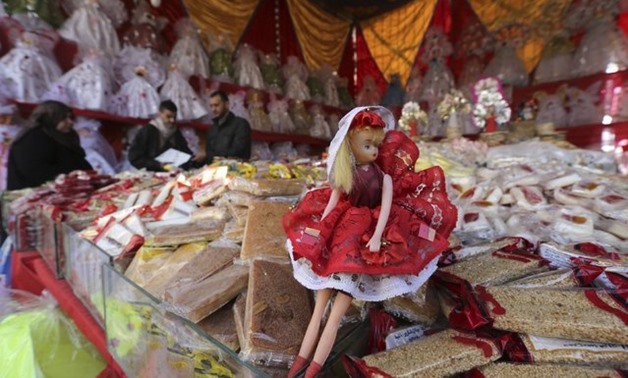
A man sells traditional doll toys and sweets for children to celebrate the birthday of Prophet Mohamed, which will fall next week, in a makeshift tent in Cairo, December 30, 2014 – REUTERS / Mohamed Abd El Ghany
CAIRO – 26 November 2017: Muslim countries celebrate the Prophet Mohamed’s birthday “Mawlid al-Nabi” every year, but celebrations vary from one country to another according to their traditions and culture. Many traditions in Egypt date back to centuries ago, the sugar doll (Arouset El-Moulid) and the sultan on a horse – also made from sugar – are no exceptions.
In Egypt and in much of the world, people celebrate Mawlid on the 12th day of the third month of the Islamic calendar, called Rabi’ al-Awwal, because the lunar calendar advances 11 days each year, meaing that the exact date changes from year to year.
This year it falls on Friday, December 1.
Many Muslims throughout the centuries have honored the birth of the Prophet in a ritual called the Mawlid. Countries celebrate through traditions and festive occasions, which include decorating their cities, and setting up tents in which sweets and candies are handed out.
Festivals of Mawlid al-Nabi are associated with Sufi strains of Islam as they are marked with poems and songs that honor the Prophet. A famous 13th century poem, "Qasida Burda," is often read in praise of the Prophet and the mercy he has brought.
The traditions and celebration’s differ from one country to another. For many Muslims, the celebrations are a longstanding historical and cultural event, through which they express their love for the Prophet.
In Egypt, the celebrations are rooted deep in the country’s history, the traditions which we know today were first introduced during the Fatimid era; before then, celebrations involved readings of the Quran only. Since Fatmid rule, public squares have been decorated, tents have been set up for Sufi singing and special Mawlid sweets have been made.
The famous sweets of Mawlid are made of sugar coated sesame, pistachio, and almond nuts, the Mawlid doll and the sultan on a horse are made of sugar and nuts decorated with colored paper.
The tale of the Mawlid doll and the knight doll
The tradition of the Mawlid doll and the ‘sultan on a horse’ also originated from the time of the Fatimid ruler El Hakim Ba’amrUllah.
However, the specific origin of the doll has been subject to much debate; everyone seems to have a different theory of how it came to be.
The majority believes that in one such Mawlid celebration, Ba’amrUllah, dressed up as a solider astride a horse and went into the town with one of his wives walking along his side, she wore a glamorous white dress with a jasmine flower crown on her head.

Knight Doll on a horse waving its sword as a sign of conquest victory, February 24, 2013 – Courtesy of YouTube / michmicha82
When candy makers saw the beauty of his wife, they decided to depict her as well as depicting Ba’amrUllah on his horse. Hence, they sculpted the sugar doll decorated with vivid colors and three circular fans attached from behind.

Sculpted sugar doll decorated with vivid colors, February 24, 2013 – Courtesy from YouTube / michmicha82
Over the years, this tradition has grown and candy makers have perfected sculpting the doll with different forms and colors.
The doll was not only a symbol of Mawlid, but also represented a newly married couple. During the Fatimid era, people would make bride and groom candies in celebration of marriages.
The doll and the sultan on a horse are made by pouring a sugary solution around a molded nut figure, coating it in a 5 cm thick layer of sugar.

The doll and the sultan on a horse are made by pouring a sugary solution around a molded nut figure, coating it in a 5 cm thick layer of sugar, February 24, 2013 – Courtesy from YouTube / michmicha82
Another tale told during the Fatimid era promised that soldiers returning from war would marry beautiful brides as a reward for their bravery; candy dolls were also made each year to honor the soldiers’ return.
The love of local folklore and the celebrations have helped in preserving the traditions of Mawlid al-Nabi since the Fatimids till now. In these celebrations, candy shoppers can use their crafting skills to remake the dolls with different colored papers and various craft supplies. People also celebrate through different festive occasions with the decorations all over the city, featuring tents in which sweets and candies are handed out and organizing games for people to enjoy.



Comments
Leave a Comment